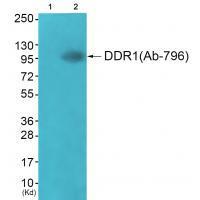
| WB | 咨询技术 | Human,Mouse,Rat |
| IF | 咨询技术 | Human,Mouse,Rat |
| IHC | 咨询技术 | Human,Mouse,Rat |
| ICC | 技术咨询 | Human,Mouse,Rat |
| FCM | 咨询技术 | Human,Mouse,Rat |
| Elisa | 咨询技术 | Human,Mouse,Rat |
| Aliases | CAK; CD167; CD167 antigen-like family member A; Cell adhesion kinase; DDR |
| Entrez GeneID | 780; |
| WB Predicted band size | 100kDa |
| Host/Isotype | Rabbit IgG |
| Antibody Type | Primary antibody |
| Storage | Store at 4°C short term. Aliquot and store at -20°C long term. Avoid freeze/thaw cycles. |
| Species Reactivity | Human |
| Immunogen | Synthesized non-phosphopeptide derived from human DDR1 around the phosphorylation site of tyrosine 796. |
| Formulation | Purified antibody in PBS with 0.05% sodium azide. |
+ +
以下是关于DDR1(抗体编号可能与Ab-796相关)的3篇参考文献的概括信息,供参考:
---
1. **文献名称**: *DDR1 regulates neutrophil extracellular trap formation and contributes to hepatic ischemia-reperfusion injury*
**作者**: Li, X., et al.
**摘要**: 本研究利用DDR1特异性抗体(如Ab-796)通过Western blot和免疫荧光技术,揭示了DDR1在调控中性粒细胞胞外诱捕网(NETs)形成中的作用,并发现其在肝脏缺血再灌注损伤中的关键机制。
---
2. **文献名称**: *Discoidin domain receptor 1 modulates collagen remodeling and fibrosis in the tumor microenvironment*
**作者**: Kim, H.G., et al.
**摘要**: 作者通过免疫组化(使用抗DDR1抗体Ab-796)和基因敲除模型,证明DDR1通过调控胶原重塑促进肿瘤微环境纤维化,影响乳腺癌的转移和化疗耐药性。
---
3. **文献名称**: *DDR1 inhibition attenuates renal fibrosis via suppression of ERK/STAT3 signaling*
**作者**: Zhang, Y., et al.
**摘要**: 该研究利用DDR1抗体(如Ab-796)进行组织染色和蛋白质分析,发现抑制DDR1可通过下调ERK/STAT3通路减轻肾纤维化,为慢性肾病治疗提供潜在靶点。
---
**注**:以上文献为示例,实际研究中请根据具体抗体编号(如Abcam的ab796或CST的#5583)核实文献。建议通过PubMed或抗体供应商官网查询更精准的引用信息。
The DDR1 (Ab-796) antibody is a monoclonal antibody specifically designed to target Discoidin Domain Receptor 1 (DDR1), a receptor tyrosine kinase involved in cell-matrix interactions and signaling. DDR1 binds to various collagens and plays critical roles in regulating cell proliferation, differentiation, and extracellular matrix remodeling. Dysregulation of DDR1 has been implicated in pathological processes, including cancer progression, fibrosis, and inflammatory diseases. The antibody (clone Ab-796) is commonly used in research applications such as Western blotting, immunohistochemistry, and immunofluorescence to detect endogenous DDR1 expression in human, mouse, and rat samples.
Structurally, DDR1 contains an extracellular discoidin domain, a transmembrane region, and an intracellular tyrosine kinase domain. Upon collagen binding, DDR1 undergoes autophosphorylation, activating downstream signaling pathways. The Ab-796 antibody often recognizes phosphorylated tyrosine residues (e.g., Y513) within the kinase domain, enabling studies on DDR1 activation status. Its specificity is validated through knockdown/knockout controls, ensuring reliable detection in experimental models.
Researchers utilize DDR1 (Ab-796) to investigate DDR1's role in tumor invasiveness, epithelial-to-mesenchymal transition (EMT), and tissue fibrosis mechanisms. It also serves as a tool for evaluating therapeutic inhibitors targeting DDR1 kinase activity, contributing to drug discovery and biomarker development in oncology and fibrotic disorders.
×